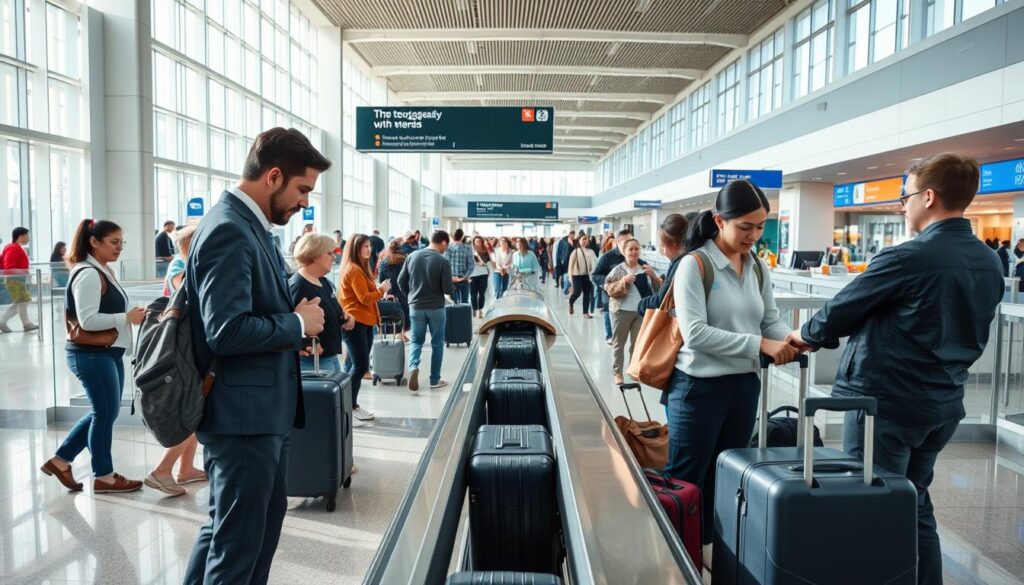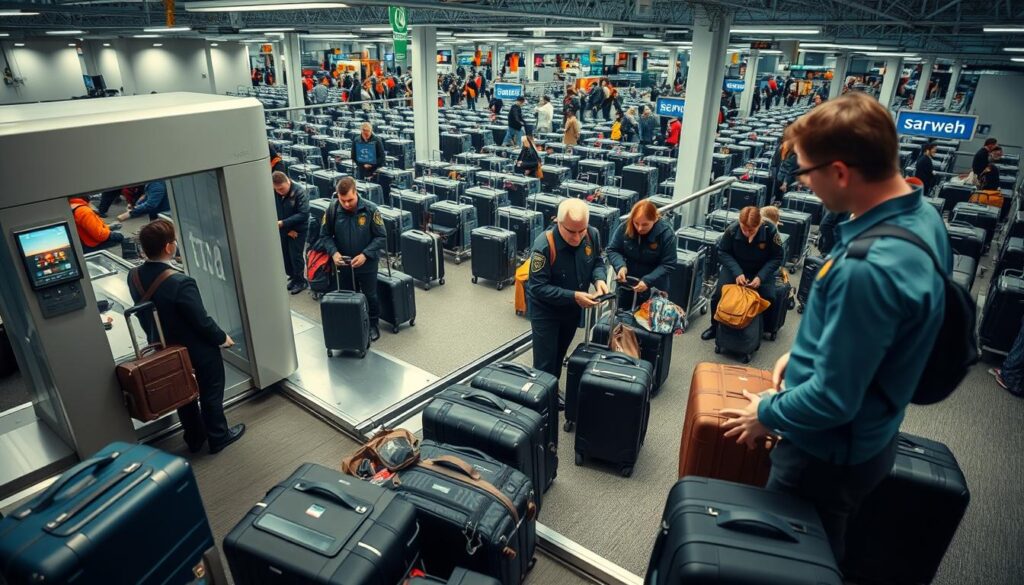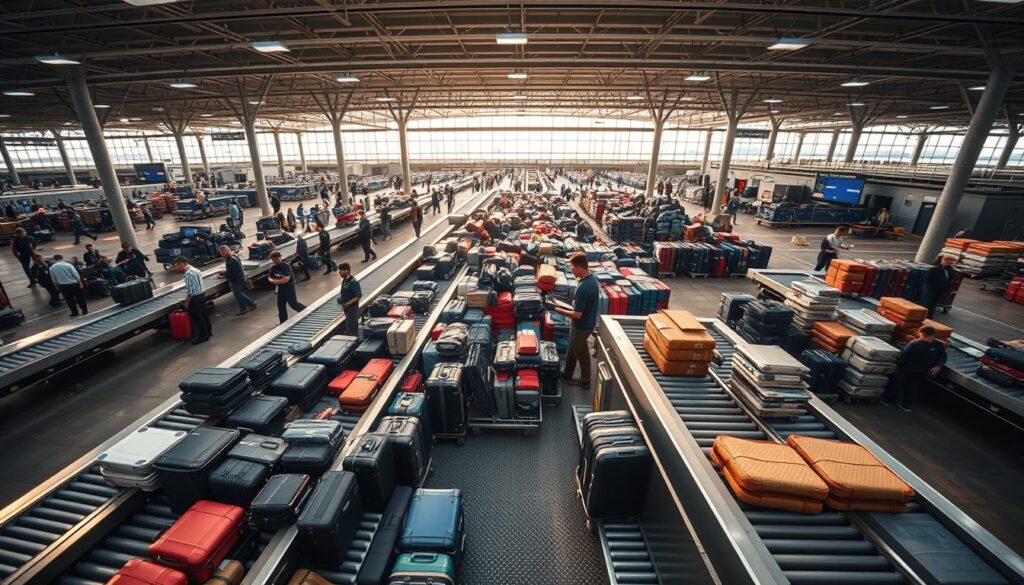What Happens to Your Luggage After You Check It In?
From the moment it’s weighed, tagged, and transported behind the curtain at check-in, your luggage embarks on its own adventure. The airline takes care of it, ensuring it reaches its destination. But have you ever wondered about the journey of your checked baggage?
The airport process involves a complex system of baggage handling, where your luggage is sorted and loaded onto the correct flight. This intricate process is designed to ensure that your bag arrives at its destination, often alongside you, but sometimes on a different path.
Understanding the luggage journey can alleviate concerns and make your travel experience smoother. Let’s dive into the details of how your checked baggage is handled from check-in to arrival.
The Check-In Process
At check-in, your luggage is not just weighed and tagged; it’s given a unique identity that helps track it throughout its journey. When you arrive at the airport, the first step in the luggage handling process begins at the check-in desk or self-service kiosk.
Your bag is placed on the scale to check if it’s within the airline’s weight limit. If it exceeds the limit, you may be required to pay an additional fee. Once weighed, your bag is tagged with a barcode or RFID chip containing your flight number, destination, and a unique code linking it to you.

The bag tag is crucial as it contains vital information that helps in sorting and tracking your luggage throughout its journey. This airline process ensures that your luggage is handled efficiently and reaches the correct flight.
Understanding the check-in process can help alleviate concerns about your luggage’s safety and give you a clearer picture of what happens after you hand it over.
Behind the Conveyor Belt: Initial Screening
Once checked in, your luggage is whisked away to undergo an initial screening, a critical step in airport security. This process is designed to detect and prevent potential threats from entering the aircraft.
The journey begins as your luggage is placed on a conveyor belt, which carries it towards the security screening area. Here, it’s subjected to an advanced scanning process, typically using Explosive Detection Systems (EDS).

The EDS process involves using X-rays and CT scans to build a 3D image of the contents of your luggage. This technology, often operated by authorities such as the Canadian Air Transport Security Authority (CATSA) in Canada, allows for a detailed examination without physically opening the bags.
The initial screening is a crucial security check that ensures the safety of all passengers. By leveraging advanced baggage screening technologies like EDS, airports can effectively identify and mitigate potential threats.
After the EDS scan, the luggage is analyzed for any suspicious items. If cleared, it proceeds to the next stage of its journey. If not, it may be subject to additional screening or manual inspection.
This rigorous process underscores the importance of security check procedures in air travel, providing a safe environment for everyone on board.
The Sorting Process
Once checked in, your luggage embarks on a journey through the airport’s automated baggage handling system. This complex network is designed to efficiently sort and route your luggage to its correct destination.
The airport’s baggage handling system is an automated network of belts and scanners that read tags and sort bags by flight and final destination. This process ensures that your luggage is directed to the correct aircraft, even if you have a connecting flight.

The sorting process involves several stages, including initial screening, sorting, and routing. At each stage, the automated system uses barcode scanning and RFID technology to track your luggage and ensure it is on the right path.
By leveraging advanced technology, airports can manage a high volume of bags efficiently, minimizing the risk of misrouting. This efficient baggage handling is crucial for maintaining the smooth operation of airport activities.
In summary, the sorting process is a critical component of airport operations, relying on sophisticated automated systems to ensure that your luggage reaches its intended destination.
What Happens to Your Luggage After You Check It In? The Journey to the Aircraft
The journey of your luggage to the aircraft is a remarkable process involving various stages. After being sorted, your luggage is loaded onto carts or into Unit Load Devices (ULDs) by baggage handlers.
These carts or ULDs are then towed to the aircraft by specialized vehicles. At the aircraft, ramp agents oversee the loading process, ensuring that luggage is efficiently loaded into the cargo hold.
The actual loading of luggage into the aircraft is done using belt loaders, which are machines that lift the bags into the hold. This process is a critical part of airline operations, requiring precision and care to ensure that all luggage is safely stowed away.
Baggage handling is a complex task that involves not just the loading of luggage but also its safe transportation to the aircraft. The entire process, from check-in to loading onto the plane, is a testament to the efficiency of modern airline operations.
In conclusion, the journey of your luggage to the aircraft is a multifaceted process that involves various stages and personnel, including ramp agents and baggage handlers. Understanding this process can give you a greater appreciation for the complexity of air travel.
In-Flight Luggage Storage
Once your luggage is loaded onto the plane, it’s stored in a specially designed cargo hold. The cargo hold is a critical component of the aircraft, designed to maintain a safe and stable environment for your checked bags.
The cargo hold is pressurized, similar to the passenger cabin, ensuring that the air pressure is maintained at a comfortable level. This pressurization is crucial for the safety of both the luggage and the aircraft. Additionally, the cargo hold is typically a bit cooler than the passenger cabin, but some planes are equipped to keep parts of the hold warm for live animals or sensitive items that require special care.
Temperature controlis another important aspect of in-flight luggage storage. Airlines take measures to ensure that the cargo hold is maintained at a suitable temperature to prevent damage to your belongings. This is particularly important for items that may be sensitive to extreme temperatures.
Overall, the conditions within the cargo hold are designed to ensure the safety and security of your luggage during the flight. By maintaining a pressurized and temperature-controlled environment, airlines can minimize the risk of damage and ensure that your bags arrive at your destination in good condition.
Arrival and Unloading Process
Upon arrival, the journey of your checked luggage from the aircraft to the baggage claim begins. As the plane lands, a team of baggage handlers takes charge of unloading your luggage from the aircraft’s hold.
The unloading process is a critical phase of airport operations, requiring precision and care to ensure that every piece of luggage is handled correctly. Your luggage is placed on carts, which are then transported into the airport’s baggage handling system.
This system is designed to efficiently sort and direct luggage to the correct baggage carousel. The arrival process is a complex sequence of events that ensures your luggage is delivered to the right place.
As your luggage makes its way through the baggage handling system, it’s being constantly sorted and routed until it reaches the designated baggage claim area. Here, you can retrieve your luggage, marking the end of its journey.
The efficiency of the baggage handling process is crucial for a smooth luggage retrieval experience. Airports continually work to improve their systems to minimize delays and ensure that passengers can quickly collect their luggage.
Conclusion
From check-in to baggage claim, your luggage embarks on a complex journey involving multiple stages. Understanding the luggage journey can alleviate concerns and make your air travel experience smoother.
The baggage handling process is a highly coordinated effort, involving initial screening, sorting, and transportation to the aircraft. Once on board, your luggage is stored in designated areas, ensuring safe transport to your destination.
Upon arrival, the unloading process begins, and your luggage is transferred to the baggage claim area. By grasping the intricacies of this process, you can better appreciate the efforts that go into ensuring your luggage reaches you safely.
In summary, the next time you check in your luggage, you’ll know the journey it takes to reach you, making your travel experience more enjoyable and stress-free.
